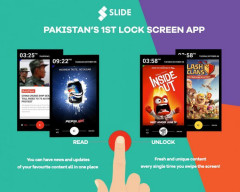
I took to a variety of group chat apps and online journal-type sites to express my thoughts. Still, that got spammy. I silenced conversations due to the excessive notifications and often had to be texted directly to be told about things. This was alright with me – I probably didn’t need to be at those events more than I needed to study for my exams.
There were plenty of people who did, though. School socialization marches on, and Pulse – a social network designed for students aged 14 to 22 – aims to be that social safe space (no parents, no teachers) of sorts for the up-and-coming generation. It’s landed US$500,000 in pre-series A funding from Saif Partners to hook students up with events and circles at their respective schools, as well as hyperlocal content in neighborhood hot spots in their city.
Pakistan-based lockscreen app closes $3.6m series A from South Korean investor
The startup raised US$200,000 seed funding a few months back from some Indian investors – including Rajan Anandan, Rajesh Sawhney, Anupam Mittal, Uday Shankar, Anand Chandrasekaran, and Amit Ranjan.
Currently present in 60 colleges in Delhi and a smattering of other communities – including one in Bangalore – the startup plans on using the funding to expand to at least 300 more universities in the following one-and-a-half months. Targeted locations include Pune, Bangalore, Mumbai, Chandigarh, Manipal, Chennai, and Hyderabad, in addition to some smaller cities in the future. The company will also put the money toward ramping up its technology team.
In 2013, LinkedIn acquired another Pulse, a Stanford student-founded mobile newsreader website with social networking features.
How to Pulse

I’m the first person to admit that Facebook knows creepily accurate things about me, but I’ve also had it show me ad after ad for adult diapers after I spent time working at a retirement agency. Pulse seeks to bypass larger social networks’ problems by providing relevant content.
It also might help stroke users’ egos a little more by showing them content that they’re more likely to watch. Livestream and video on the app can get an average of 400 to 500 views, co-founder Prakhar Khanduja shares. Prakhar and IIT-Roorkee grad Karthik Vaidyanath launched Pulse last month after working with InstaLively, a previous livestreaming product that was ultimately unsuccessful. They now head up the startup’s team of about 20.
“We [society] are moving away from text,” Prakhar shares. “To be honest, I don’t like texting.”
Users can create a Pulse account by linking the Android app to their Facebook. People do have to hit an age requirement to use the app, and I ask if that works even if one has his or her age hidden on Facebook. “How many people actually hide their age on Facebook at that age?” Prakhar asks.
Pulse users will also have the option of keeping a post private to show to their “friends” (friending on Pulse works much like it does on Facebook or other social networking outlets), posting to a particular university group or locality, or making a post or video stream public across channels.
For those worried about stickers – don’t worry, the app’s got them and plans on making them available in a number of Indian languages. At the moment, the stickers are available in English, with a few Punjabi selections.
Tech support: P@SHA assists startups to find investors
More socializing for your data
Prakhar did not reveal the number of active users but said that, of the over 10,000 app downloads, 40 per cent of the user base posts content; and 30 per cent of the user base currently posts content daily.
Mindful to how large bandwidth is a problem in India, Prakhar says the app uses a “tap-tap-tap experience” instead of Facebook’s or Instagram’s scroll-to-load model. That helps conserve data and compete with Snapchat, which is popular among the younger demographic but also can suck the life out of your data allowance.
“I don’t call it a success,” Prakhar says about the funding. “We continue to succeed, [and] we don’t have to worry about money anymore.”
This article originally appeared on Tech in Asia.




















1714024018-0/ModiLara-(1)1714024018-0-270x192.webp)























COMMENTS
Comments are moderated and generally will be posted if they are on-topic and not abusive.
For more information, please see our Comments FAQ